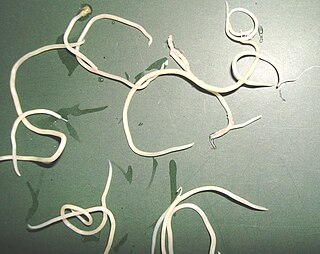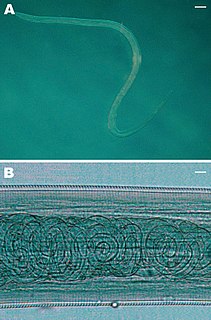 W
WAscaridia galli is a parasitic roundworm belonging to the phylum Nematoda. Nematodes of the genus Ascaridia are essentially intestinal parasites of birds. A. galli is the most prevalent and pathogenic species, especially in domestic fowl, Gallus domesticus. It causes ascaridiasis, a disease of poultry due to heavy worm infection, particularly in chickens and turkeys. It inhabits the small intestine, and can be occasionally seen in commercial eggs.
 W
WThe Ascarididae are a family of the large intestinal roundworms. Members of the family are intestinal parasites, infecting all classes of vertebrates. It includes a number of genera, the most well known of which are:
 W
WCapillariidae is a family of parasitic nematodes. All its members are parasites in vertebrates when they are in their adult stage.
 W
WGongylonema is a genus of thread-like nematode that was described by Molin in 1857. It is the only currently valid genus in the family Gongylonematidae, though the mysterious Spiruroides – usually placed in the Subuluridae, which are not closely related to Gongylonema among the Spiruria – might actually belong here. They are parasites of birds and mammals, transmitted by insects. Some 38 species are known, about 12 of which have been recorded in Europe.
 W
WHeterakis gallinarum is a nematode parasite that lives in the cecum of some galliform birds, particularly in ground feeders such as domestic chickens and turkeys. It causes infection that is mildly pathogenic. However, it often carries a protozoan parasite Histomonas meleagridis which causes of histomoniasis. Transmission of H. meleagridis is through the H. gallinarum egg. H. gallinarum is about 1–2 cm in length with a sharply pointed tail and a preanal sucker. The parasite is a diecious species with marked sexual dimorphism. Males are smaller and shorter, measuring around 9 mm in length, with a unique bent tail. Females are stouter and longer, measuring roughly 13 mm in length, with a straight tail end.
 W
WOxyurida is an order of nematode worms of the class Secernentea. It consists of four families, one of which contains the human pinworm.
 W
WOxyuridae is a family of nematode worms of the class Secernentea. It consists of eight genera, one of which contains the human pinworm.
 W
WThe Syngamidae are a family of nematodes which commonly parasitize mammals, birds, and rarely humans. They are classified in the Strongyloidae superfamily and Strongylata order.
 W
WThelazia is a genus of nematode worms which parasitize the eyes and associated tissues of various bird and mammal hosts, including humans. They are often called "eyeworms", and infestation with Thelazia species is referred to as "thelaziasis". Adults are usually found in the eyelids, tear glands, tear ducts, or the so-called "third eyelid". Occasionally, they are found in the eyeball itself, either under the conjunctiva or in the vitreous cavity of the eyeball. All species of Thelazia for which the life cycle has been studied are transmitted by species of Diptera (flies) which do not bite, but which feed on tears.
Trichinella is the genus of parasitic roundworms of the phylum Nematoda that cause trichinosis. Members of this genus are often called trichinella or trichina worms. A characteristic of Nematoda is the one-way digestive tract, with a pseudocoelom.
 W
WTrichinella britovi is a nematode parasite responsible for a zoonotic disease called trichinellosis. Currently, eight species of Trichinella are known, only three of which cause trichinellosis, and Trichinella britovi is one of them. Numerous mammal species, as well as birds and crocodiles, can harbor the parasite worldwide, but the sylvatic cycle is mainly maintained by wild carnivores.
 W
WThe Trichocephalida is an order of parasitic nematodes.